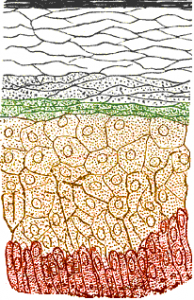| English: Skin layers (Photo credit: Wikipedia) |
Sorry for going back to the skin imaging theme once again. During Dicoderm discussion, we discussed about the growing importance of photodiagnosis (diagnosing dermatological condition from an image, without actually seeing the patient). We realised that we may be good at recognizing large and complex patterns but we may be poor at quantifying and assessing the subtle differences. This makes photodiagnosis a difficult skill to master and it may be different from clinical diagnosis in-vivo. In photodiagnosis large and complex patterns are often hidden, with subtle color difference cues available in abundance. An organized crowdsourcing platform for photo-diagnosing is taking shape here in dermgrandrounds. But I will blog about it in detail later.
When I explored the color space for skin tone assessment (CHARM), I considered the possibility of some diagnostic information being hidden in the color space matrix. I even discussed it with few of my friends ( SK and +Feroze Kaliyadan ). (BTW All the best SK with your new baby IDS, I just saw the website when I googled your name). I wanted to subject the data to some machine learning algorithm such as a tree classifier or SVM. But I didn’t have enough data.
Korean scientists from the Seoul National University College of Medicine and Seoul National University Bundang Hospital, have done just that. A decision tree with enough specificity to differentiate erythrotelangiectatic rosacea, papulopustular rosacea and seborrheic dermatitis has been published in BJD recently (1) (Print version may not be out yet). A full five peels to this research. (OK, I am biased 🙂 Hopefully the research team will someday see my CHARM!
Here is a short but useful review on selective hair therapy.(2) The authors argue that novel technologies that could improve guidance into hair follicles (= higher selectivity, sparing of unaffected tissue), retention (= reduced application frequencies, increased and prolonged exposure to the drug) and protection from degradation in the skin environment is already available. But they are yet to become effective products. Are we obsessed with Amanda’s Apple?
1. Characteristics of subjective recognition and computer-aided image analysis of facial erythematous skin diseases: A cornerstone of automated diagnosis. Choi, J W; Kim, B R; Lee, H S; Youn, S W (2013) The British journal of dermatology [Pubmed]
2. Selective hair therapy: bringing science to the fiction. Vogt, Annika; Blume-Peytavi, Ulrike (2014) Experimental dermatology. vol. 23(2) p. 83-6 [Pubmed]
Reviewed by Bell Eapen on .
The computer-aided image analysis result of facial erythema is well correlated with the actual clinical diagnosis of erythrotelangiectatic rosacea (ETR), papulopustular rosacea (PPR), and Seborrheic dermatitis (SEB).
PeelScore rating: 5

- Machine learning-based BOTOX API - April 11, 2023
- Skinmesh: Machine learning for facial analysis - November 10, 2020
- Free Dermatology EMR for Machine Learning and Artificial Intelligence - January 2, 2020







Leave a Reply